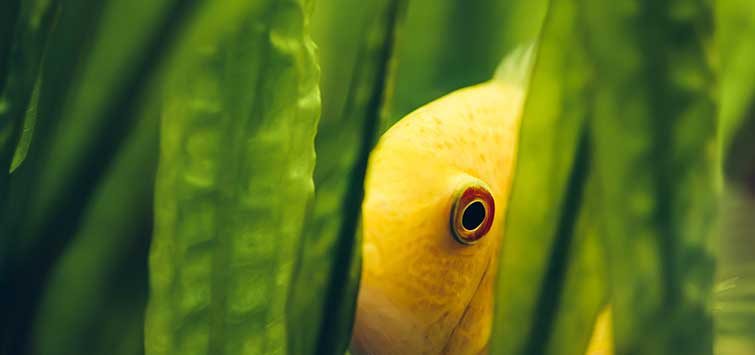Expressing Perspective Through Aquatic Plant Arrangement
Author: Takashi Amano
The aquascaping master describes a novel technique for creating the illusion of depth in a layout through creative planting.
It is a law of nature that an object that is up close appears large while an object far away appears small. This law also applies when trying to express the sense of depth in a layout. In the Nature Aquarium, a layout is generally divided into the foreground, midground, and background, and aquatic plants are planted in such a way that the heights of plants gradually become taller, going from the foreground to the background.
However, in order to emphasize a sense of depth, a different planting method is occasionally employed to clearly distinguish a close-up view and a distant view. In a previous layout, I employed a method for creating a close-up view with branch wood and a distant view with yamaya stones. This month I am going to introduce a method that combines aquatic plants with different-sized leaves to create the sense of depth.
Soil Mounding Creates Perspective
The dimension of the aquarium I am working with is W90 x D45 x H45 cm (35 x 20 x 20 inches). This is a very popular aquarium size in Japan, and it is typically called a 90-cm aquarium. In a conventional layout, a large planting space is provided in the rear of the aquarium (the background), and since the front-to-back dimension in this aquarium is only 45 cm (20 inches), the planting space in the front would normally be somewhat small. However, for this layout, a large space is provided for planting in the front, and the planting space in the back is made small by the rock arrangement that constitutes the midground being positioned slightly toward the back. This was done to create a section for a close-up view by planting voluminous stem plants in the planting space in the front.
The section for the distant view, which is composed of the rock arrangement and the rear planting area, was sloped higher toward the back when the substrate was built, and extra soil was mounded to increase the height of the area further. Tall stem plants or tape-shaped aquatic plants are planted in the background in a conventional layout. However, the back of this layout was raised by mounding soil, since tall aquatic plants cannot be used for the expression of a distant view in this layout. Sloping the substrate greatly in the back section emphasized the sense of depth even more, considering the actual front-to-back distance of the aquarium.
Somewhat small ryuoh stones with a rocky appearance were used as objects in the distant view to express a sense of depth instead of using them to create a powerful iwagumi arrangement in a layout. Doing so expresses a view of mountains in the distance. The sense of depth was already created in this layout through optical illusion before planting aquatic plants.
Aquatic Plants can Emphasize Contrast
As for aquatic plants, a sense of depth is emphasized by the contrast between bushes of Hygrophila polysperma on the right and left, Australian dwarf Hydrocotyle with relatively large leaves in the front, and Glossostigma with small leaves in the rear. Since Hygrophila polysperma has rather large leaves for a stem plant, it is not suitable for a delicate layout. However, it is effective for creating a contrast with the sizes of leaves in a layout like this one. It is very sturdy and tolerates repeated trimming, and is therefore quite suitable for use in such a layout with bushes in the front.
Although stem plants tend to become very sparse in the lower part of their stems, the runners and leaves of Australian dwarf Hydrocotyle, which was used in combination with Hygrophila polysperma, became interwoven and created well-integrated bushes with the H. polysperma. The same Australian dwarf Hydrocotyle spread its runners toward the open space in the front center and made a nice contrast with the leaves of Glossostigma in the back. While Glossostigma was also planted in the open space in the center front area, Australian dwarf Hydrocotyle and Riccia obscured it, creating a change in the front and the rear sections.
Maintaining Aquatic Plants
The technique to create a sense of depth with planting is not complete with the planting of aquatic plants. How these aquatic plants are grown out and maintained afterward is an important part of it.
First, Hygrophila polysperma needs to be shaped into a nice bush by frequent trimming, since it tends to look untidy if left unrestrained. In particular, a new shoot that sticks out of the bush needs to be cut off right away. You can create a dense bush by doing so consistently.
Since Australian dwarf Hydrocotyle grows especially fast, it had to be trimmed quite frequently to keep it from covering up the Glossostigmain the front and sending out runners to the back.
Lastly, the Glossostigma was also trimmed frequently in order to keep its leaves as small as possible. Scissors with an angled shaft and curved tips are convenient for trimming this type of undergrowth. As a matter of fact, they were quite useful for trimming the plants in this layout.
The Glossostigma and Riccia in the front were trimmed together. Since Riccia will grow back from small pieces left among Glossostigma runners, you can shear them casually to a uniform height.
Data
Aquarium: Cube Garden W90 x D45 x H45 cm
Lighting: Grand Solar I (NAG-150W-Green, NA PC lamp 36W x 2), turned on for 10 hours per day
Filter: Super Jet Filter ES-600 (Bio Rio, NA Carbon)
Substrate: Aqua Soil Amazonia, Power Sand Special M, Bacter 100, Clear Super, Penac W/for Aquarium, Penac P, Tourmaline BC
CO2: Pollen Glass Large 30, 3 bubbles per second via CO2 Beetle Counter (using Tower)
Aeration: For 14 hours after the light is turned off using Lily Pipe P-4
Additives: Brighty K, Green Brighty STEP2
Water Change: 1/3 once a week
Water Quality: Temperature 25ºC (77ºF), pH 6.8, TH 50 mg/l
Aquatic Plants: Hygrophila polysperma, Hydrocotyle sp., Glossostigma elatinoides, Riccia fluitans
Fish and Invertebrates: Hemigrammus ocellifer, Otocinclus sp., Caridina japonica
See the full article on TFH Digital http://www.tfhdigital.com/tfh/201109#pg59

.png?h=595&iar=0&w=2781&hash=5FD5E69473BCC22199FBFA2FB71B6033)



